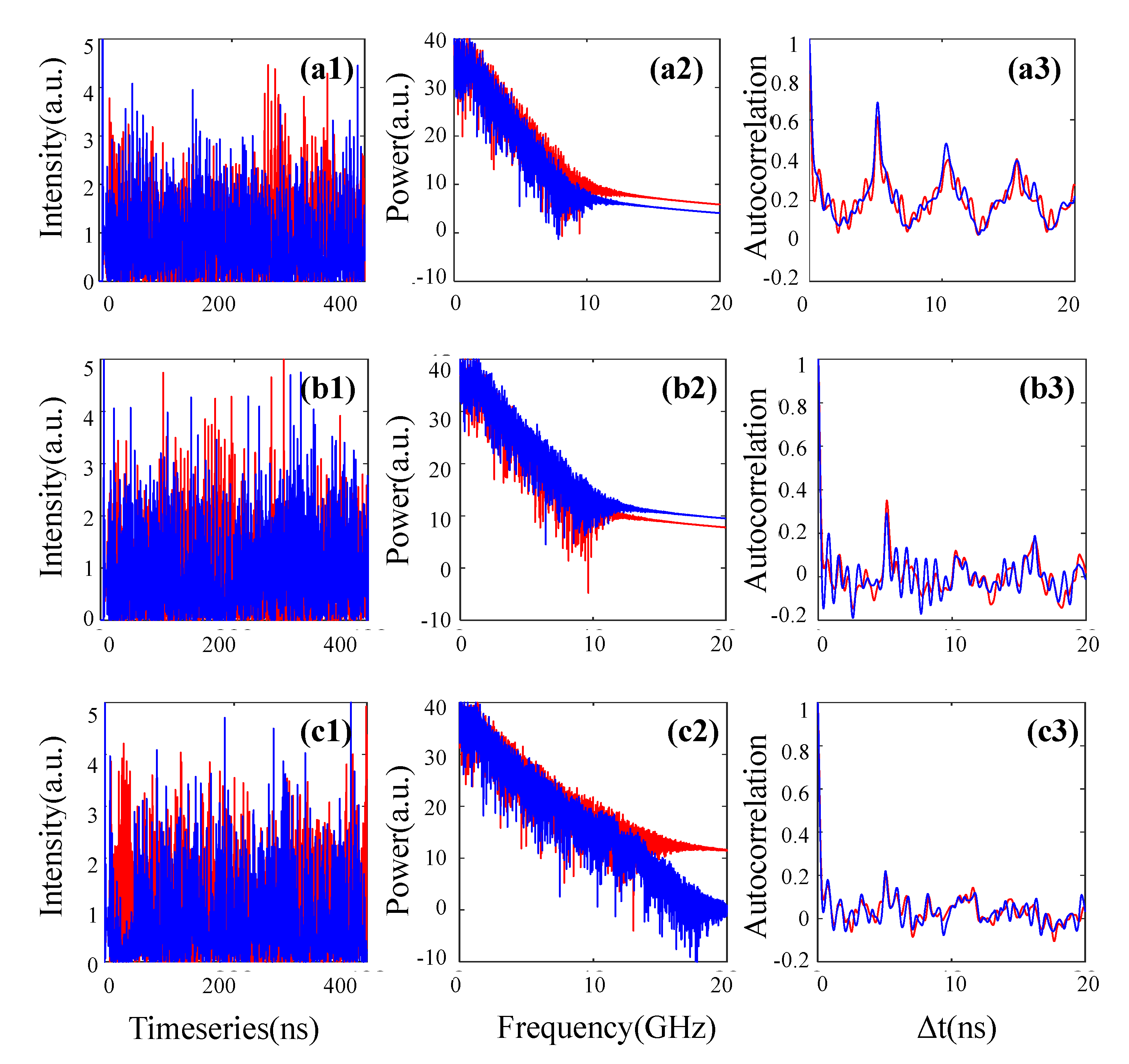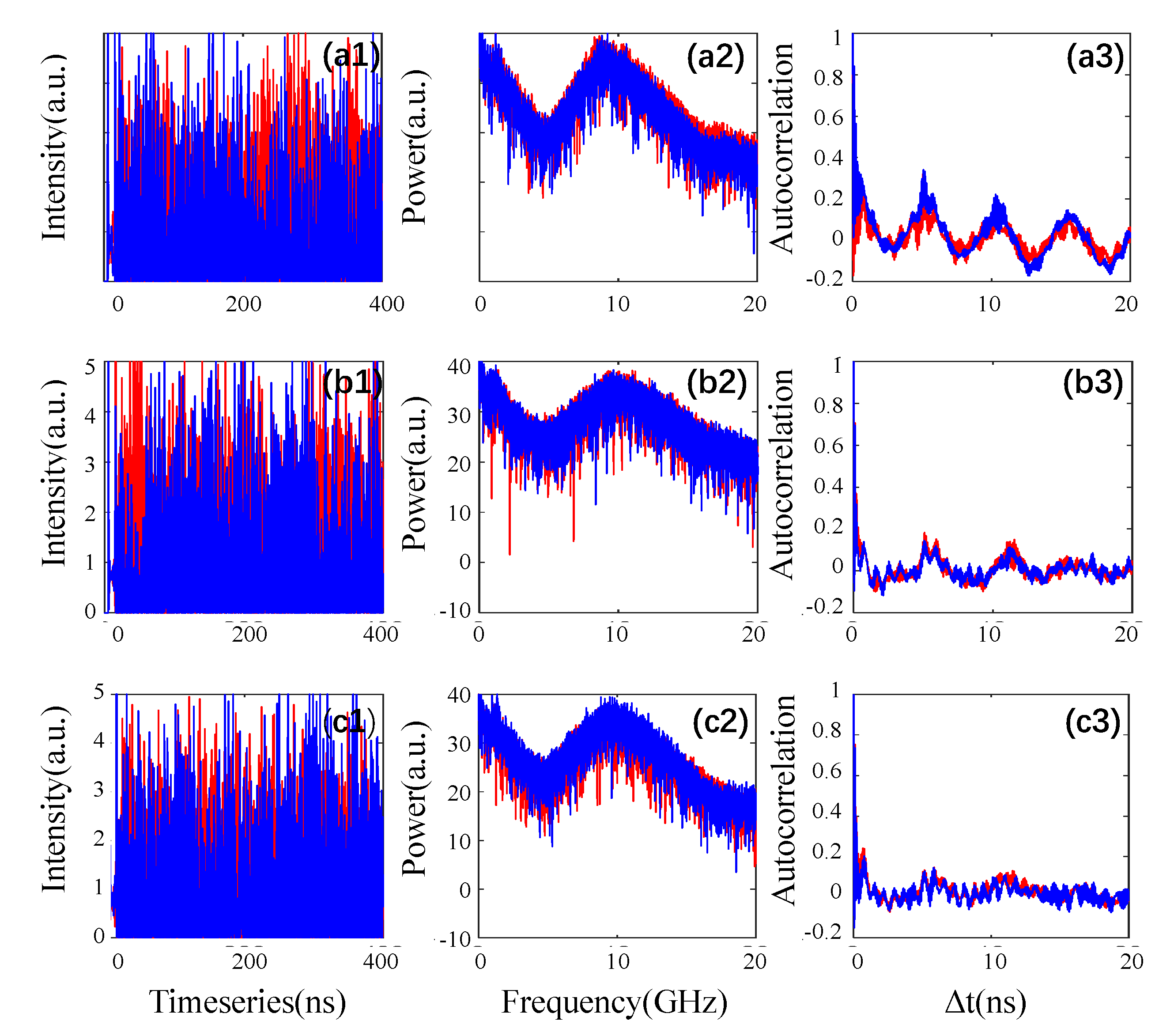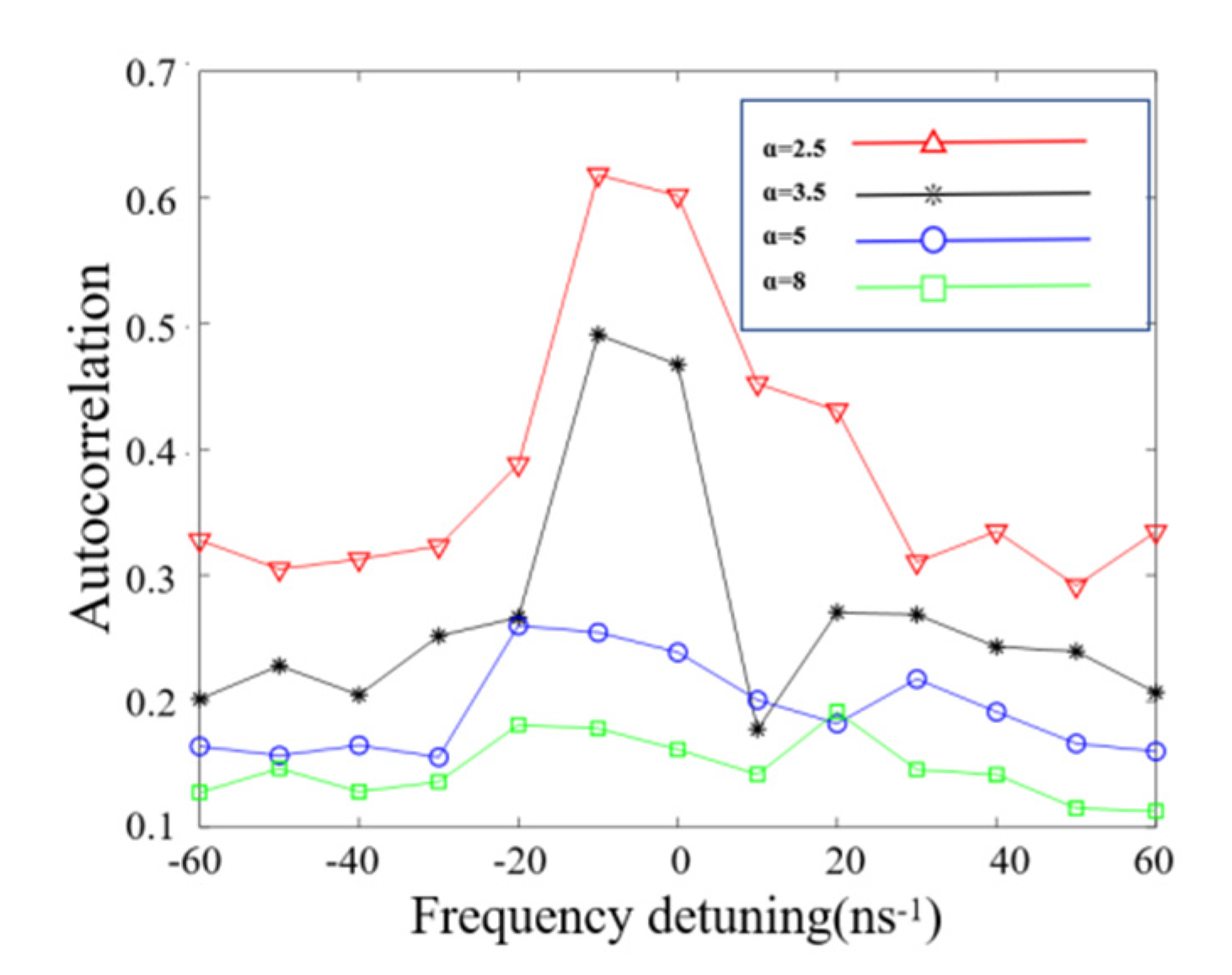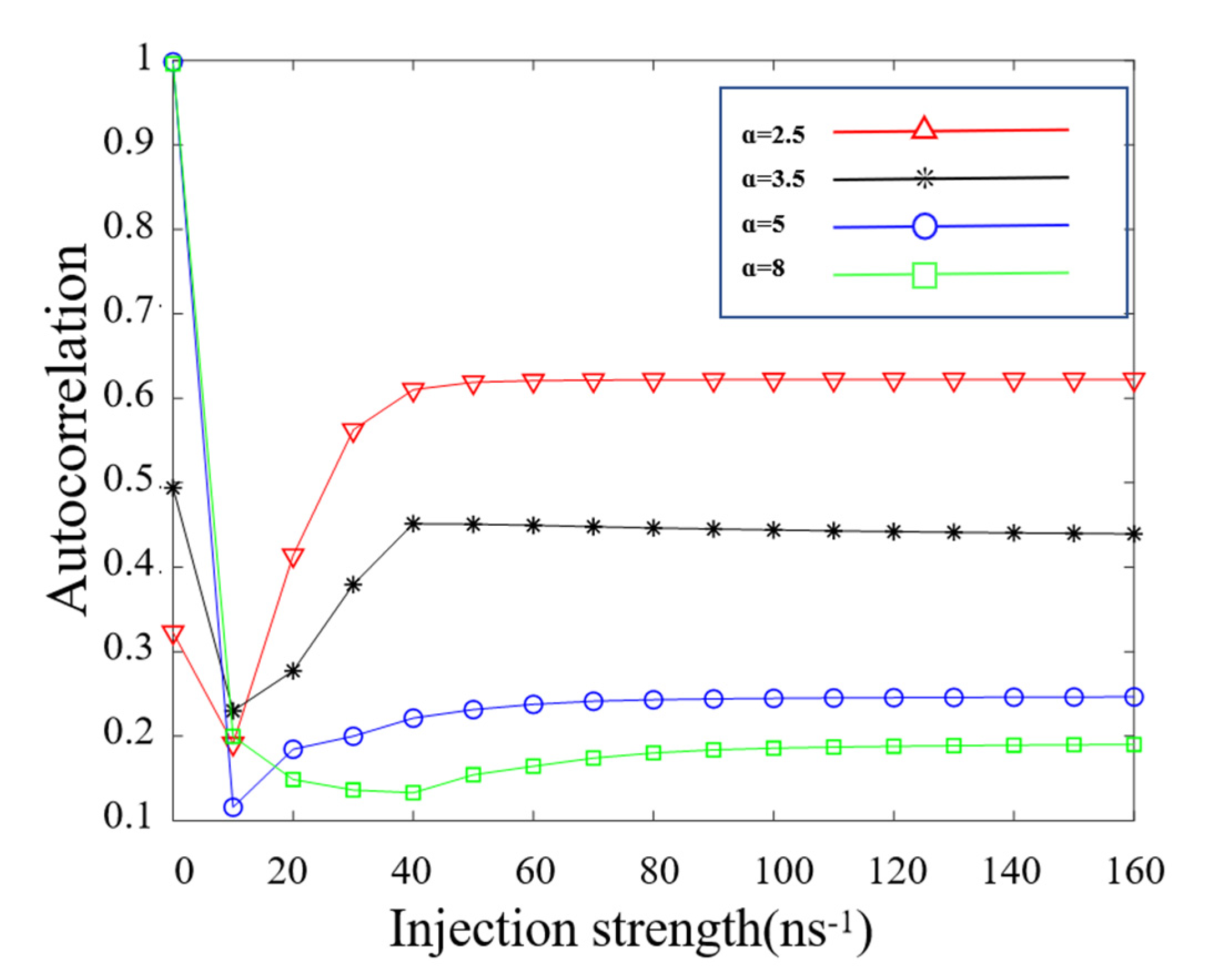Influence of Linewidth Enhancement Factor on the Nonlinear Dynamics and TDS Concealment of Semiconductor Ring Lasers
Abstract
:1. Introduction
2. Theoretical Model
3. Numerical Results
3.1. Dynamical Mappings of MSRL
3.2. TDS Suppression
4. Conclusions
Author Contributions
Funding
Institutional Review Board Statement
Informed Consent Statement
Data Availability Statement
Acknowledgments
Conflicts of Interest
References
- Argyris, A.; Syvridis, D.; Larger, L.; Annovazzi-Lodi, V.; Colet, P.; Fischer, I.; García-Ojalvo, J.; Mirasso, C.R.; Pesquera, L.; Shore, K.A. Chaos-based communications at high bit rates using commercial fibre-optic links. Nature 2005, 438, 343–346. [Google Scholar] [CrossRef]
- Li, N.; Susanto, H.; Cemlyn, B.; Henning, I.D.; Adams, M.J. Secure communication systems based on chaos in optically pumped spin-VCSELs. Opt. Lett. 2017, 42, 3494–3497. [Google Scholar] [CrossRef]
- Spitz, O.; Herdt, A.; Wu, J.; Maisons, G.; Carras, M.; Wong, C.-W.; Elsäßer, W.; Grillot, F. Private communication with quantum cascade laser photonic chaos. Nat. Commun. 2021, 12, 3327. [Google Scholar] [CrossRef]
- Zhao, A.; Jiang, N.; Liu, S.; Zhang, Y.; Qiu, K. Physical layer encryption for WDM optical communication systems using private chaotic phase scrambling. J. Lightw. Technol. 2021, 39, 2288–2295. [Google Scholar] [CrossRef]
- Guo, Y.; Cai, Q.; Li, P.; Zhang, R.; Xu, B.; Shore, K.A.; Wang, Y. Ultrafast and real-time physical random bit extraction with all-optical quantization. Adv. Photon. 2022, 4, 035001. [Google Scholar] [CrossRef]
- Tseng, C.; Funabashi, R.; Kanno, K.; Uchida, A.; Wei, C.-C.; Hwang, S.-K. High-entropy chaos generation using semiconductor lasers subject to intensity-modulated optical injection for certified physical random number generation. Opt. Lett. 2021, 46, 3384–3387. [Google Scholar] [CrossRef]
- Yoshiya, K.; Terashima, Y.; Kanno, K.; Uchida, A. Entropy evaluation of white chaos generated by optical heterodyne for certifying physical random number generators. Opt. Express 2020, 28, 3686–3698. [Google Scholar] [CrossRef]
- Rontani, D.; Choi, D.; Chang, C.-Y.; Locqet, A.; Citrin, D. Compressive Sensing with Optical Chaos. Sci. Rep. 2016, 6, 35206. [Google Scholar] [CrossRef] [Green Version]
- Xiang, S.; Zhang, Y.; Guo, X.; Wen, A.; Hao, Y. Photonic generation of neuron-like dynamics using VCSELs subject to double polarized optical injection. J. Lightw. Technol. 2018, 36, 4227–4234. [Google Scholar] [CrossRef]
- Feng, W.; Jiang, N.; Zhang, Y.; Jin, J.; Zhao, A.; Liu, S.; Qiu, K. Pulsed-chaos MIMO radar based on a single flat-spectrum and Delta-like autocorrelation optical chaos source. Opt. Express 2022, 30, 4782–4792. [Google Scholar] [CrossRef]
- Tseng, C.-H.; Hwang, S.-K. Broadband chaotic microwave generation through destabilization of period-one nonlinear dynamics in semiconductor lasers for radar applications. Opt. Lett. 2020, 45, 3777–3780. [Google Scholar] [CrossRef]
- Zhao, A.; Jiang, N.; Zhang, Y.; Peng, J.; Liu, S.; Qiu, K.; Deng, M.; Zhang, Q. Semiconductor Laser-Based Multi-Channel Wideband Chaos Generation Using Optoelectronic Hybrid Feedback and Parallel Filtering. J. Lightw. Technol. 2022, 40, 751–761. [Google Scholar] [CrossRef]
- Sciamanna, M.; Shore, K. Physics and applications of laser diode chaos. Nat. Photon. 2015, 9, 151–162. [Google Scholar] [CrossRef] [Green Version]
- Wang, X.; Wu, Z.; Jiang, Z.; Xia, G. Nonlinear dynamics of two-state quantum dot lasers under optical feedback. Photonics 2021, 8, 300. [Google Scholar] [CrossRef]
- Li, N.; Susanto, H.; Cemlyn, B.R.; Henning, I.D.; Adams, M.J. Stability and bifurcation analysis of spin-polarized vertical-cavity surface-emitting lasers. Phys. Rev. A 2017, 96, 013840. [Google Scholar] [CrossRef] [Green Version]
- Quintero-Rodríguez, L.; Zaldívar-Huerta, I.; Hong, Y.; Masoller, C.; Lee, M.W. Permutation entropy analysis of the output of a laser diode under stimulated Brillouin scattering optical feedback. Opt. Express 2021, 29, 26787–26792. [Google Scholar] [CrossRef]
- Xu, M.; Zhang, F.; Pu, M.; Li, X.; Ma, X.; Guo, Y.; Zhang, R.; Hong, M.; Luo, X. Metasurface spatiotemporal dynamics and asymmetric photonic spin-orbit interactions mediated vector-polarization optical chaos. Phys. Rev. Res. 2021, 3, 013215. [Google Scholar] [CrossRef]
- Rontani, D.; Locquet, A.; Sciamanna, M.; Citrin, D.S.; Ortin, S. Time-delay identification in a chaotic semiconductor laser with optical feedback: A dynamical point of view. IEEE J. Quantum Electron. 2009, 45, 879–891. [Google Scholar] [CrossRef]
- Priyadarshi, S.; Hong, Y.; Pierce, I.; Shore, K.K. Experimental investigations of time-delay signature concealment in chaotic external cavity VCSELs subject to variable optical polarization angle of feedback. IEEE J. Sel. Top. Quantum Electron. 2013, 19, 1700707. [Google Scholar] [CrossRef]
- Nguimdo, R.; Colet, P.; Larger, L.; Pesquera, L. Digital key for chaos communication performing time delay concealment. Phys. Rev. Lett. 2011, 107, 034103. [Google Scholar] [CrossRef] [Green Version]
- Jiang, P.; Zhou, P.; Li, N.; Mu, P.; Li, X. Optically injected nanolasers for time-delay signature suppression and communications. Opt. Express 2020, 28, 26421–26435. [Google Scholar] [CrossRef]
- Wu, J.; Xia, G.-Q.; Wu, Z.-M. Suppression of time delay signatures of chaotic output in a semiconductor laser with double optical feedback. Opt. Exp. 2009, 17, 20124–20133. [Google Scholar] [CrossRef]
- Liu, S.; Jiang, N.; Jiang, N.; Zhao, A.; Zhang, Y.; Qiu, K. Chaos synchronization and communication in globalsemiconductor laser network with coupling time delaysignature concealment. Appl. Opt. 2020, 59, 6788–6795. [Google Scholar] [CrossRef]
- Ma, Y.; Xiang, S.; Guo, X.; Song, Z.; Wen, A.; Hao, Y. Time-delay signature concealment of chaos and ultrafast decision making in mutually coupled semiconductor lasers with a phase-modulated Sagnac loop. Opt. Express 2019, 28, 1665–1678. [Google Scholar] [CrossRef]
- Guo, Y.; Fang, X.; Zhang, H.; Zhao, T.; Virte, M.; Guo, X. Chaotic time-delay signature suppression using quantum noise. Opt. Lett. 2021, 46, 4888–4891. [Google Scholar] [CrossRef]
- Mu, P.; Pan, W.; Yan, L.; Luo, B.; Zou, X. Optimizing chaos time-delay signature in two mutually-coupled semiconductor lasers through controlling internal parameters. Mod. Phys. Lett. B 2017, 31, 1750106. [Google Scholar] [CrossRef]
- Lang, R.; Kobayashi, K. External optical feedback effects on semiconductor injection laser properties. IEEE J. Quantum Electron. 1980, 16, 347–355. [Google Scholar] [CrossRef]
- Li, N.; Nguimdo, R.M.; Locquet, A.; Citrin, D.S. Enhancing optical-feedback-induced chaotic dynamics in semiconductor ring lasers via optical injection. Nonlinear Dyn. 2019, 92, 315–324. [Google Scholar] [CrossRef]






Publisher’s Note: MDPI stays neutral with regard to jurisdictional claims in published maps and institutional affiliations. |
© 2022 by the authors. Licensee MDPI, Basel, Switzerland. This article is an open access article distributed under the terms and conditions of the Creative Commons Attribution (CC BY) license (https://creativecommons.org/licenses/by/4.0/).
Share and Cite
Wang, Y.; Wang, X.; Mu, P.; Guo, G.; Liu, X.; Wang, K.; He, P.; Hu, G.; Jin, G. Influence of Linewidth Enhancement Factor on the Nonlinear Dynamics and TDS Concealment of Semiconductor Ring Lasers. Electronics 2022, 11, 2007. https://doi.org/10.3390/electronics11132007
Wang Y, Wang X, Mu P, Guo G, Liu X, Wang K, He P, Hu G, Jin G. Influence of Linewidth Enhancement Factor on the Nonlinear Dynamics and TDS Concealment of Semiconductor Ring Lasers. Electronics. 2022; 11(13):2007. https://doi.org/10.3390/electronics11132007
Chicago/Turabian StyleWang, Yichen, Xianglong Wang, Penghua Mu, Gang Guo, Xintian Liu, Kun Wang, Pengfei He, Guoying Hu, and Gang Jin. 2022. "Influence of Linewidth Enhancement Factor on the Nonlinear Dynamics and TDS Concealment of Semiconductor Ring Lasers" Electronics 11, no. 13: 2007. https://doi.org/10.3390/electronics11132007
APA StyleWang, Y., Wang, X., Mu, P., Guo, G., Liu, X., Wang, K., He, P., Hu, G., & Jin, G. (2022). Influence of Linewidth Enhancement Factor on the Nonlinear Dynamics and TDS Concealment of Semiconductor Ring Lasers. Electronics, 11(13), 2007. https://doi.org/10.3390/electronics11132007





